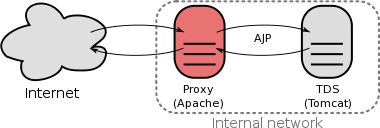- Rename the
thredds.war file to match the desired context path before you deploy it to Tomcat.
Tomcat and other servlet engines direct incoming requests to a particular web application when the beginning of the request URL path matches the
context path of that particular webapp. The
easiest way to let Tomcat (or any other servlet engine) know what context path to use for a given webapp is to rename that webapp's
.war
file before deploying it to Tomcat.
For instance, if you want all URLs starting with
/thredds2
to be handled by your TDS install, rename the
thredds.war
file to
thredds2.war
before you deploy it to Tomcat.
If the desired context path is a multi-level context path (e.g.,
/my/thredds
), you must use a pound sign ("#") in the
.war
filename to encode the slash ("/"). In this case, the
thredds.war
file would need to be renamed to
my#thredds.war
.
Keep in mind
The deployment descriptor (
web.xml
file) is overwritten during deployment which means this edit must be done every time the TDS is re-deployed.
- Edit the TDS
web.xml file and change the value of the "ContextPath" parameter to match the desired context path.
The TDS uses the value of the "ContextPath" context parameter (as defined in the TDS
web.xml
file) when generating TDS URLs in certain situations. To make sure all generated URLs are consistent, you must change the value of the
"ContextPath" parameter to match the desired context path.
(Changing the value of "ContextPath" will no longer be necessary in a future release once we require Tomcat 6.0 (Servlet 2.5).
The TDS
web.xml
file is located in
${tomcat_home}/webapps/<contextPath>/WEB-INF/web.xml
, where
<contextPath>
is the value of the desired context path. The "ContextPath" context parameter is defined in the
web.xml
file (starting at line 12):
<context-param>
<param-name>ContextPath</param-name>
<param-value>thredds</param-value>
</context-param>
For the
/thredds2
example, it should be changed to:
<context-param>
<param-name>ContextPath</param-name>
<param-value>thredds2</param-value>
</context-param>
And for the
/my/thredds
example, it should be changed to:
<context-param>
<param-name>ContextPath</param-name>
<param-value>my/thredds</param-value>
</context-param>
- Edit your TDS configuration catalogs and change the service base URLs to start with the desired context path
So that users will receive the correct data access URLs for datasets served by your TDS, the
base URLs given by the service elements in your TDS configuration catalogs must match the desired
context path.
An OPeNDAP service element on a TDS with the context path of
/thredds2
would need to look similar to this:
<service name="odap" serviceType="OPeNDAP" base="/thredds2/dodsC/"/>
And similarly, an OPeNDAP service element on a TDS with the context path of
/my/thredds
would need to look similar to this:
<service name="odap" serviceType="OPeNDAP" base="/my/thredds/dodsC/"/>
